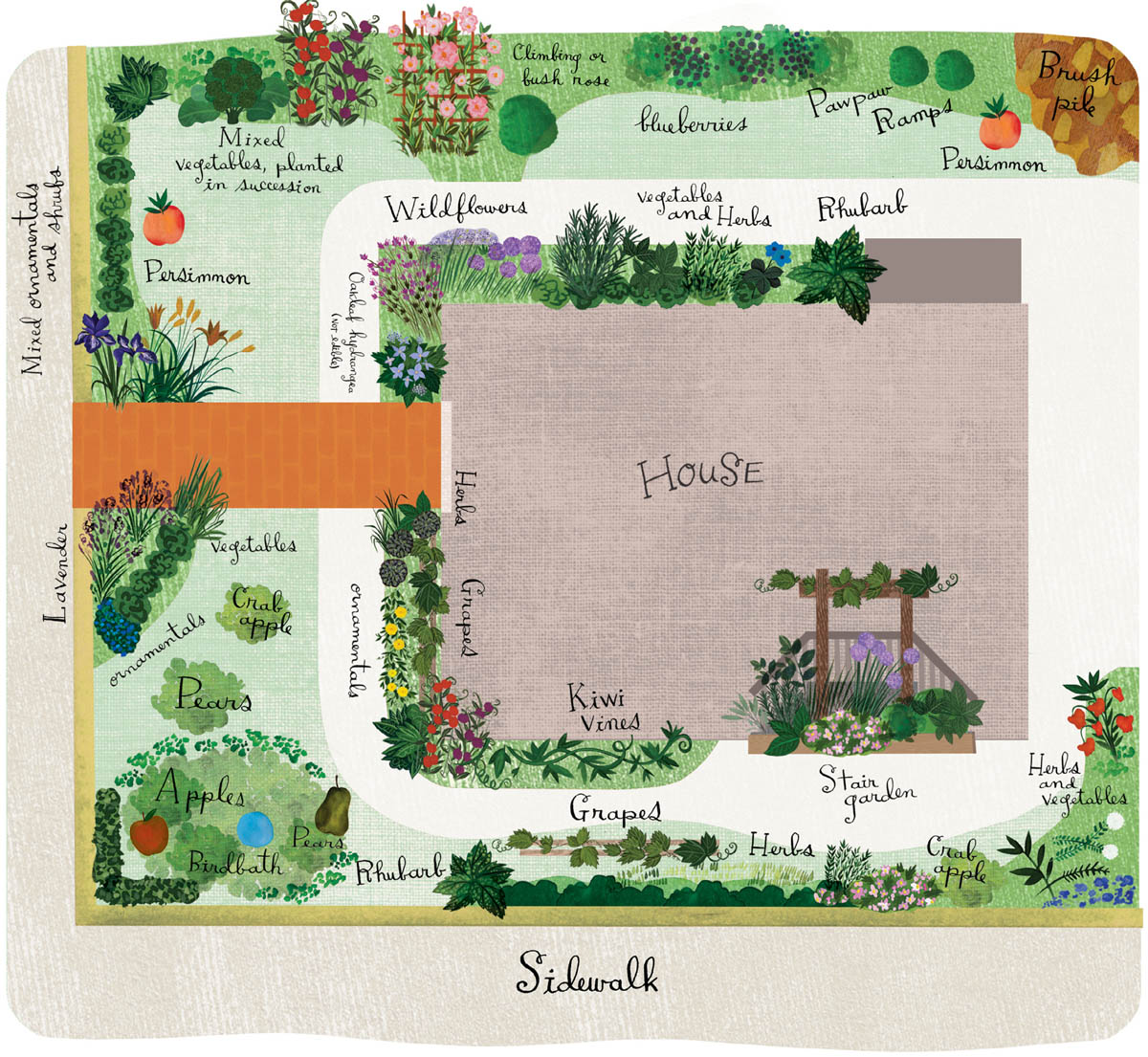Nan’s Garden Plan

Traditionally, the front yard of a home is reserved for a lawn and maybe a foundation planting of trees and shrubs. Nan Chase upends conventional thought by growing fruiting trees, shrubs, and vines, as well as vegetables and herbs, alongside the ornamental plants in her landscape. The end result? Her small garden is able to supply much of her family’s fruit and vegetable needs for the year and the majority of their fresh herbs.
Nan Chase has the good fortune to live in an ideal gardening climate near the Blue Ridge Parkway, a national park that runs through the Appalachian Mountains. Mild temperatures, lots of sunshine, and healthy biodiversity reign in this part of the world. The good climate, along with being a stay-at-home mom to three kids, gave her the opportunity to experiment with growing a wide range of edible plants. “I was encouraged to plant varieties that looked beautiful and produced a lot of food,” she says. Her plan is based on her own garden, which is just under 1/10 of an acre and includes a wide range of edible plants in informal beds.
Along with the vegetables, Nan has included trees, shrubs, vines, herbs, and wildflowers — plants she says are equally important. “To me, ‘eat your yard’ means gardening for landscape beauty that lasts through the four seasons,” she says. “In some cases, I mix attractive edibles into ornamental plantings — Swiss chard, herbs, and roses, for example — but I also have a couple of all-vegetable spaces.” She evaluates her plants from year to year to assess whether she has really used and liked them, and whether they are reliable.
She recommends that gardeners experiment with both common and unusual plants. For example, almond, peach, and pear trees are excellent landscape plants that are beautiful in full springtime bloom. For outstanding fall color, Nan suggests a sugar maple, pawpaws, serviceberries (also called Saskatoons or Juneberries), blueberries, and pomegranates.
Nan says to avoid planting these in your edible yard, due to their less-than-appealing appearance or pest and disease issues: zucchini, squash, cucumbers (“bugs and powdery mildew”), and tomatoes (“seriously homely, and everyone offers you their excess fresh ones”).
Delicious and beautiful. Her best-tasting edibles include ‘Callaway’ crab apples (“the fruits are so sweet and juicy”), leeks, scallions (green onions), rugosa roses (“the hips!”), blueberries, and green beans (“they are incomparably tender and have such delicate flavor”). Of course, many of her favorite edibles are also extremely ornamental. “On the pretty side, some of the climbing or runner beans have lovely flowers and graceful habits,” she notes. Then there are the “neutral” plants, which she says “disappear into the general look of an ornamental bed but provide lots of food.” Among these are soybeans, which grow to be about 2 feet tall, and bush beans that can be broadcast in a small circle.
Certain areas of Nan’s yard are dedicated to mixed vegetable and herb production, which allows the crops to be easily changed throughout the season as plants are harvested. Larger fruiting plants such as crab apples, apples, pawpaws, pears, and blueberries are more permanent elements in the garden, but no less essential as they provide fruit and year-round interest and act as a screen against street traffic. Nan cautions that the trees and shrubs will require a bit more patience than the quick-growing annual vegetables and herbs. “My pawpaw had fruit this year for the first time — seven years as advertised!” she says with a laugh. Her pomegranates may never bear fruit in her rather cool climate, though she still holds out hope.
Vining interest. To take advantage of vertical space, Nan trains vines like kiwi and grape to climb pillars, trellises, and the two big posts near her stair garden, where she weaves the vines along the railings as they grow. Permanent gravel pathways lead the way around the yard, connecting each section of the garden and permitting easy access to the edible plants.
